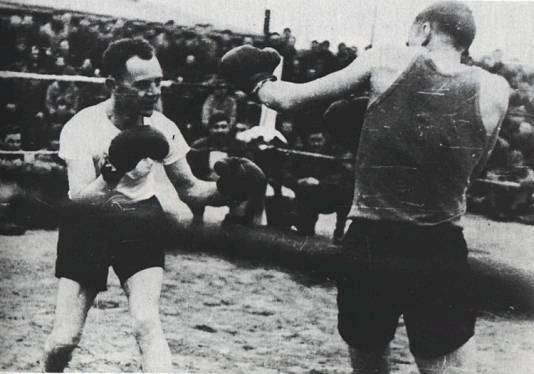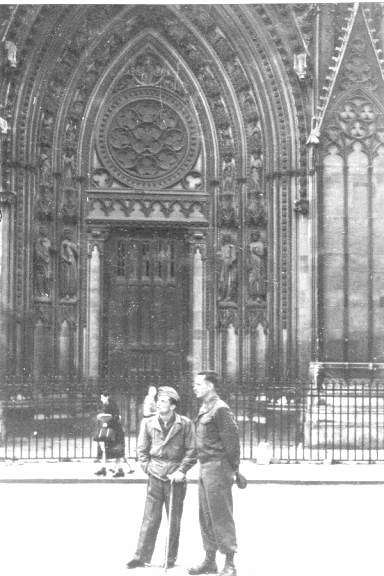This is one of the stranger stories of luck and
coincidence to come out of WW2, one that has been shared with too few over
the last 55 years
By: Carter Harrison
My father, Major Cyrus E. Manierre, US Army, volunteered for a
"hazardous and dangerous operation" in the spring of 1943. The
organization to which he volunteered his services was the Office of
Strategic Services, the "OSS". On 25 May 1944 after a flight
from Algiers, Team Dodge consisting of Major Manierre and Sgt L.T.
Durocher parachuted into occupied France at Beaurepaire l'Isere and began
the expected OSS actions of organizing the local Maquis, sabotaging troop
trains, blowing up power plants, demolishing bridges etc.
(Note: Map courtesy of www.expedia.com)
All was progressing well until 5 August when the truck in which he
was a passenger was stopped at a roadblock and he found himself arrested
by the Milice (Vichy French collaborators). After several days in the
hands of the Milice he was driven to Lyons, to Gestapo headquarters. Six
days of unpleasant incarceration began, as the thugs were convinced
(correctly so) that he was a spy and a saboteur, so they spared little
effort in their interrogation. His treatment at their hands ended when the
FFI (French Forces of the Interior) liquidated the Gestapo and blew up
part of their headquarters.
As luck would have it, the German Army took over, found my father in
his cell, and although he was dressed in a decidedly non-standard
"uniform", believed his story of being a downed aviator who was
wearing civilian clothes given him by the Maquis and who had been on his
way to Spain when caught and turned over to the Gestapo. Therein followed
18 more days in the cell in Lyons, followed by a 15-day train-ride that
ended at Oberusal -- Dulag-Luft, the interrogation camp for airmen. In his
interrogation there, after 8 days of solitary, he continued his story of
being a downed pilot. The interrogator (I have no data as to whether this
was Hanns Scharff) happened to have a full file on him, which included the
fact that he had been taking flight training. Fortunately omitted was the
fact that he had washed out of flight school after cracking up a plane!
Accordingly he was sent to Wetzlar, a transit camp.
The story continues in the words of Irwin Stovroff, Navigator of the B-24
"Passion Pit", shot down over Rouen on 13 August 1944 (related
in Gerald Astor's excellent book THE MIGHTY EIGHTH):
"Bill (co-pilot Bill Manierre) and I were sitting there and he
said to me 'Russian - my nickname -'look over there. There's a guy staring
at me and you. Do you know him? Were we in some camp with him? Did we fly
with him somewhere?' I looked at the man, a gaunt guy, deep-sunk eyes,
thin as a rail and mustache. I said 'Bill, I don't know the guy. I don't
think I've ever seen him before in my life.'
"'But he keeps looking at us,' said Bill. 'Oh my God! That's my
brother!' It was unbelievable when the two of them got together and they
seemed to recognize one another at the same moment, and began
hugging."
The Germans made a big thing out of it when they found they had brothers
there, and sent them both off to Stalag Luft 1, where Major Manierre got
the post of Adjutant to Col. Gabby Gabreski, CO of North 3.
Roger Armstrong, another "guest" of the Luftwaffe, had
this to say about him in his book USA THE HARD WAY (Quail House Publishing
Co. Orange County, CA): "Major Cy Manierre, who was all "spit
and polish," with his shined paratrooper boots, was an enigma to the
POWs. We heard that paratroopers were shot when captured. But he was
alive, hungry and cold like the rest of us. Later I learned from Col.
Gabreski that he had been in the infantry. Most of us thought he was a
captured OSS Officer. In any event, he also waited for Captain Probst to
salute him first before returning the salute."
Another piece I gleaned comes from Hub Zemke's book ZEMKE'S STALAG
(Smithsonian University Press, Washington and London). This concerns the
various "extra-curricular" activities that kriegies became
involved in, one of which was a boxing match in which Col. Zemke was to
fight; many were eager to take a poke at the S.A.O. Accordingly: "To
ensure the selection was seen to be fair, all names of would-be opponents
were written on slips of paper and Group Captain Weir asked to draw one
from the hat. The chosen name was that of Major Cyrus Manierre, Gabreski's
Adjutant in North 3, a big lean US paratrooper who professed to have done
a bit of boxing at West Point as a cadet. As can be seen from the
particulars that were displayed in a Provisional Wing X bulletin, about
the only advantage I had was experience.
Vital statistics of the two opponents:
| |
Colonel Zemke |
Major Manierre |
| Weight: |
10
st. 10 lbs |
11
st. 6 lbs |
| Height: |
5
ft. 9 ins. |
6
ft. 1 in. |
| Age: |
31 years |
25 years |
| Eyes: |
Steel gray |
Now dark blue |
| Hair: |
Brown (graying) |
Curly black |
| Training Diet: |
Distilled water and cigar
butts |
Kriegsbrot, Schnapps, schrimpers and
rice |
| Ability: |
55 bloody matches all in rings |
Intercollegiate matches, street and
bar-room clashes |
"The moment arrived when my opponent and I ducked under the
ropes. My only misgiving was that I had not had any time to get in a
little training to limber up. In the opening round the stringy Manierre
showed a good straight left but began to tire and waste away after a few
punches had been landed on his torso.

(Photo from ZEMKE'S STALAG)
"In the second round he was decked with a solid right hook
cross and from then on I carried him through the last round. Zemke
received a unanimous decision for what was to be his last boxing match in
any ring."
The tale must end here only because I have no other
information. Pop was eventually liberated and went to Camp Lucky Strike,
although he managed to spend a good deal of time in Paris. We were sent
the picture below, found in the US Air Force Academy Archives, of Pop
and some other gentleman standing in front of a church, the Abbey
of St. Ouen in Rouen, France (near
camp Lucky Strike).

If you have any information about Major Manierre, or his activities
In the camp (or after Liberation), escape activities if any, his family would
really appreciate being contacted via email at carterbear1@hotmail.com
.
|
|
The following questions were submitted to Major
Manierre's son Carter by some students. Carter's answers are in
CAPS.
Why do you think that he volunteered for that
"hazardous & dangerous operation?"
POP WAS BORED SILLY RUNNING AROUND IN THE CAROLINA
WOODS. HE HAD GRADUATED FROM WEST POINT IN MAY 1942 AND WANTED TO GET INTO
THE WAR. INSTEAD HE WAS LIVING IN CAROLINA TRAINING. BORING...
Why did he get arrested?
HE WAS IN A TRUCK, THEY WERE CARRYING EXPLOSIVES TO
DO ANOTHER JOB AND THE MILICE (FRENCH COLLABORATORS AND TRAITORS) BETRAYED
HIM. THEY ACTUALLY KNEW THAT HE WAS NOT A FRENCHMAN BUT AN AMERICAN AGENT.
SO THE MILICE, NOT BEING ON THE SAME SIDE AS THE MAQUIS (FRENCH RESISTANCE),
TURNED HIM OVER TO THE GESTAPO.
Why did the German Army decide to take over
Manierre? .
THE MAQUIS DID A RAID ON GESTAPO HQ IN LYON AS THEY
KNEW POP WAS BEING HELD THERE. UNFORTUNATELY, ALTHOUGH ALL THE GESTAPO THUGS
WERE KILLED, POP WAS IN A CELL TOO DEEP IN A CELLAR FOR THE RESISTANCE TO
FIND HIM IN THE AMOUNT OF TIME THEY HAD. SO THEY HAD TO LEAVE HIM. THE
WEHRMACHT (GERMAN ARMY) CAME IN TO HANDLE THE AFTERMATH OF THE RAID AND
FOUND POP IN THE CELL.
What made the Germans dress Manierre in a
"non-standard uniform?"
THE GERMANS DIDN'T DRESS HIM IN THIS, THAT IS WHAT
HE WAS WEARING AS DISGUISE. HE WAS A SPY, SO WAS WEARING FRENCH FARMER
CLOTHING TO BLEND IN WITH THE OTHER FRENCHMEN WHO WERE FIGHTING THE GERMANS.
BUT HE STILL HAD HIS "DOG TAGS" AS AMERICAN ID.
Why didn't the Manierre Brothers recognize each
other?
FIRST OF ALL BECAUSE BOTH WERE SORT OF SCRUFFY
LOOKING. POP HAD BEEN BEATEN PRETTY THOROUGHLY BY THE GESTAPO FOR ABOUT A
WEEK, PLUS WAS WEARING A MUSTACHE (WHICH WAS FORBIDDEN AT WEST POINT AND
WHICH UNCLE WILL HAD NEVER SEEN HIM DO). ON TOP OF THAT, NEITHER KNEW WHERE
THE OTHER WAS AT THE TIME. PLUS POP WAS ARMY, SO TO BE IN AN AIR FORCE
PRISON CAMP WAS TOO STRANGE, AS USUALLY ARMY WENT TO DIFFERENT CAMPS THAN
AIR FORCE.
Why did the Germans make a big thing of it when
they found that they had brothers at their camp?
BECAUSE THEY COULD SAY "LOOK, WE FOUND THESE TWO
BROTHERS, WE SENT THEM TO THE SAME CAMP SO THEY COULD BE TOGETHER, AREN'T WE
GREAT" EG: NOT AS BAD AS ALL THE WORLD THOUGHT.
How did Bill Manierre get to the camp?
HIS PLANE, A B-24 NAMED "THE PASSION PIT" WAS SHOT
DOWN BY FLAK OVER ROUEN WHEN THEY WERE BOMBING THE GERMANS TO HELP WITH THE
BREAKOUT FROM THE NORMANDY BEACHES. AS A PILOT HE WAS SENT TO AN
AIR FORCE POW CAMP.
Why do you think Cyrus waited for Captain Probst to
salute him before he saluted him back?
POP WAS A MAJOR, AND CAPTAIN PROBST WAS, WELL, A
CAPTAIN. SO POP HAD HIGHER RANK AND THUS THE LOWER RANK SHOULD SALUTE FIRST.
THERE WEREN'T A LOT OF WAYS THAT POWS COULD FIGHT BACK AGAINST THE GERMANS,
AFTER ALL, THEY WERE PRISONERS OF THE GERMANS WHO HAD THE GUNS AND THE FOOD
AND WEREN'T THE FRIENDLIEST OF CAPTORS.
How do you think Cyrus felt about fighting that big
lean U.S. paratrooper?
HE WAS THE BIG LEAN PARATROOPER. THE MAN HE FOUGHT
WAS COLONEL "HUB" ZEMKE WHO HAD BEEN COMMANDER OF "ZEMKE'S WOLFPACK" - A
SQUADRON OF P-47 FIGHTER PLANES BEFORE HE WAS SHOT DOWN.
In the weight division of the two opponents, what
does the st. mean?
IT'S A ABBREVIATION FOR "STONE" WHICH IS A BRITISH
MEASUREMENT, I THINK 20 LBS.
How do you think that he felt about losing the
boxing match?
NOT REALLY HAPPY, BUT THE IDEA WAS MORE TO
ENTERTAIN THE OTHER PRISONERS, AND EVERYONE WAS MAKING BETS, SOLDIERS ALWAYS
LIKE TO SEE SOMEONE TRY TO TAKE DOWN THEIR COMMANDER, ETC. BUT THEY WERE
FRIENDLY TO EACH OTHER.
Why were the brothers sent the picture that was
found in the U.S. Air Force Academy Archives?
THAT'S ONE OF THE WEIRDER THINGS. THE PICTURE WAS
GIVEN TO A FORMER JED NAMED JOE DEFRANCESCO WHO KNEW MY FATHER. HE
RECOGNIZED THE PICTURE OF POP, COMMENTED ON IT AND WAS GIVEN A COPY, WHICH
HE SENT TO MY MOTHER, WHO SENT IT TO ME SO THAT I COULD COPY IT AND SPREAD
IT AROUND.
|
